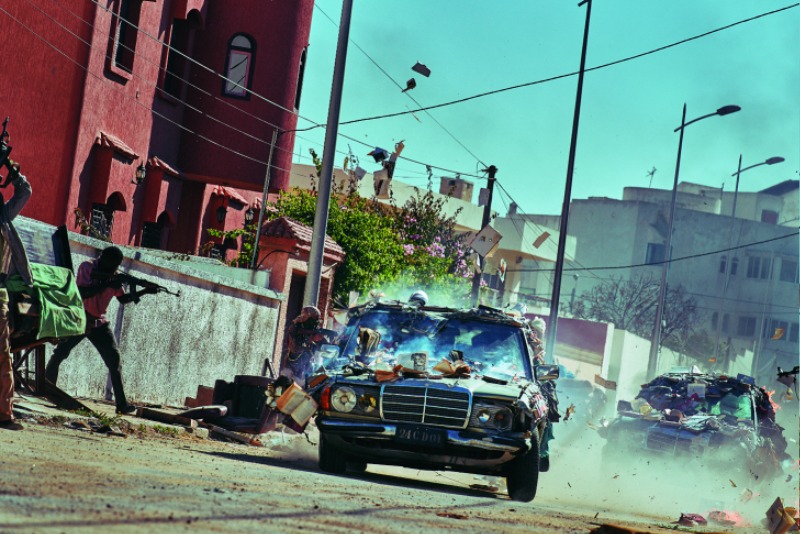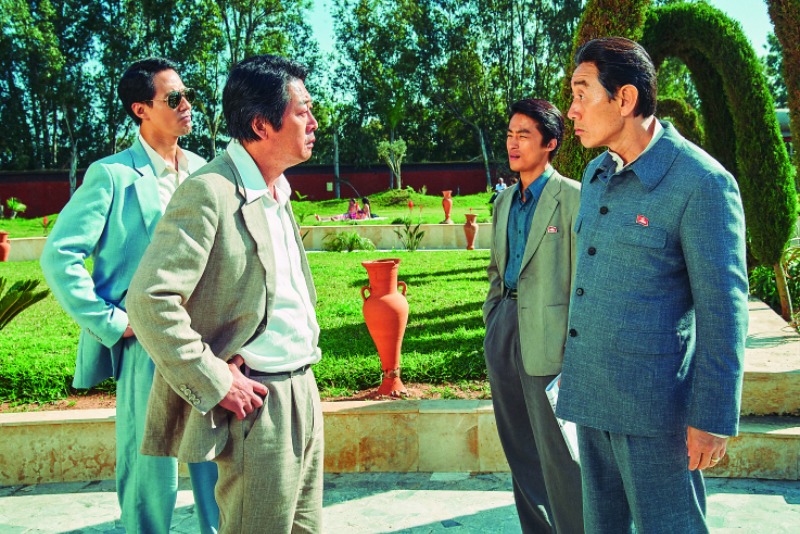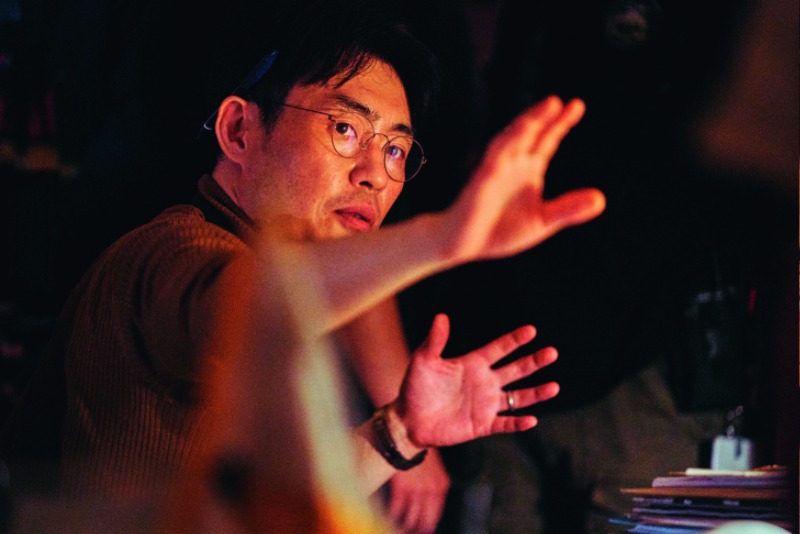The 2021 movie “Escape from Mogadishu” depicts how survival instincts replaced reflexive trepidation between diplomats of North and South Korea. The movie is set in the civil war in Somalia 30 years ago, when the two Koreas competed for the African country’s support for their respective UN membership.

The highlight of the movie “Escape from Mogadishu” is when South and North Korean embassy employees and their families pile into four cars and dodge gunfire as they race through the Somali capital. Most of the movie, without the help of computer graphic, was shot in Essaouria, Morocco, which resembles Mogadishu.
© Lotte Entertainment
As the Taliban recaptured Kabul in August, Afghan workers of the Korean Embassy and their families were hurriedly evacuated to Korea to avoid possible reprisals. The emergency airlifts, code-named “Operation Miracle,” contrasted sharply with another dire situation experienced by Korean diplomats 30 years earlier.
Back then, it was a handful of trapped Korean Embassy workers and their families desperately struggling to flee the civil war in Somalia. The chaos and danger were no less extreme than in Afghanistan, but communication links were lost. The ordeal of the embassy staffers went largely unnoticed.
Coincidentally released at the end of July, just days before the Afghan government collapsed, “Escape from Mogadishu” connected immediately with audiences, tallying three million admissions in just a month – no small feat when pandemic restrictions in Korea suppressed ticket availability per showing. When Ryoo Seung-wan, the director, was given an account of Operation Miracle, he rhetorically asked whether he should do a movie on that, too. A smile emoji accompanied this musing in his email.
MEASURED STEPS
The scenes depicted in “Escape from Mogadishu” may seem to be the byproduct of overactive imaginations. And yet, they are true. In early December 1990, Somali rebels entered Mogadishu and battled government forces through the end of the month for control of the capital. Eventually, the rebels began to target foreign embassies that had worked with President Mohamed Siad Barre as well. That put the North Korean Embassy in particular in their crosshairs. North Korea had invested considerable time into cultivating relations with African nations, including the longstanding Siad Barre dictatorship in Somalia.
Ultimately, it became too dangerous for the North Korean diplomats and their families to stay where they were. They fled their embassy and ended up at the place they most despised. The South Korean Embassy, also imperiled, opened its doors, and those from both sides of the peninsula crossed the Rubicon. From that point on, survival depended on their audacious collaboration. Mutual animosity and suspicion had to be cast aside in order to devise an escape from the bloody chaos.
A friend related the Somalia episode to Ryoo and said that Seoul-based Dexter Studios, maker of the “Along with the Gods” franchise, was interested in bringing the escape to movie theaters. Two years later, Dexter Studios asked Ryoo to direct the project.
“I was curious about what had happened, so I looked up relevant information in the media,” Ryoo said. “It was such a dramatic story and I hoped that, whoever took the wheel, a well-made movie would come out of it.”
What especially intrigued Ryoo was that the embassy personnel were civilians, lacking the military or espionage experience or skill to plot a safe exit. “The suspense d from ordinary people facing a dramatic situation was quite interesting, and I felt that it would be possible to make a film trying new approaches that differed from previous films. That was the driving force that moved me,” Ryoo said. He researched the facts again and reconstructed the events.

The scene shows tense relationship between diplomats of the two Koreas. Kim Yoon-seok acts as the South Korean ambassador (second from left) against Heo Joonho as his North Korean counterpart.
© Lotte Entertainment
TWO WARS
The film spans a six-week period, starting in early December 1990 and ending on January 12, 1991, when the embassy workers finally succeeded in their escape. Ryoo was faithful to the background and progression, or the sequence of historical facts, and at the same time, reorganized the details of the characters and events. Keeping all the elements in sync was the main challenge.
“Somalia was undergoing socio-political turmoil. How should the film show the turbulence? Amid the turmoil, the North and South Korean embassy workers and their families spent 12 days together at the South’s embassy residence before their escape. How to describe their time together was key.”
Two wars unfold on screen. The first half of the movie focuses on the diplomatic warfare between the North and South Korean ambassadors as they pursue support for their respective nation’s admission to the United Nations. In his attempts to lobby the Somali leadership, the South Korean envoy hits obstacles and falls into traps laid by the North Koreans, who had been operating in Africa for decades.
This first half is also dedicated to shaping the characters and establishing the background leading up to the Somali Civil War. Ryoo dissected his intentions at length.
“In order for the audience to connect to the characters and experience the war together, the least I owed them was to realistically show how the whole turmoil came about. I was quite nervous up until the premiere. The person who makes the film knows all the events that take place, forwards and backwards, but for the audience it’s their first encounter. I was worried about failing to convey to them the unfamiliar historical setting. Thankfully, I think the audience was able to grasp the tumultuous developments in the movie without much difficulty.”
The inter-Korean power game , which initially leans in the North’s favor, rebalances and gives equal weight to the two Koreas by the time the civil war erupts. After the rebels make their way into Mogadishu and seize control of the government, the storyline shifts from a North-South diplomatic contest to a joint escape from the city.
From the moment the South Korean ambassador decides not to turn away the North Korean embassy workers asking for help, the embassy employees of the two Koreas begin to look collectively in the same direction. They don’t have time to worry about facing suspicion and possible punishment for making unauthorized contact with their main foe. All that matters is getting out alive.
MAKESHIFT ESCAPE

Ryoo Seung-wan won Best Director at the 2021 Korean Association of Film Critics Awards on November 10 for “Escape from Mogadishu.” The movie has been selected as the South Korean entry for the Best International Feature Film category of the 94th Academy Awards, slated for March 2022.
© Lotte Entertainment
“Escape from Mogadishu” shares elements of two Hollywood escape movies based on actual events: “Black Hawk Down” (2001) and “Argo” (2012). The former, also set in Somalia, narrates the effort to extract U.S. soldiers cornered in Mogadishu’s shattered warrens after the fall of the Siad Barre regime. The latter depicts the rescue of U.S. diplomats from Tehran during the 1979-1981 Iran hostage crisis. But in these episodes, U.S. military or government officials were involved. In contrast, “Escape from Mogadishu” traces a makeshift escape without any government assistance by a fragile alliance that must divorce ideology at a time when the Cold War still holds sway.
About midway into the movie, the embassy workers from both Koreas have their first dinner together. The wife of the South Korean ambassador has trouble picking up a side-dish perilla leaf and the North Korean ambassador’s wife helps with her chopsticks.
In their escape from the South Korean Embassy, some 20 embassy staffers and their families filling four cars struggle to survive firebombs and gunfire to reach the Italian Embassy. This is by far the highlight of the movie as well as the defining sequence that displays Ryoo’s humanistic embrace.
Obstacles prevent the cars from speeding through Mogadishu, so the focus isn’t on the vehicles, stunt driving or special effects. Instead, Ryoo keeps movie watchers inside the cars to share the suspense, tension and terror of the passengers.
“I had to keep it as realistic as possible – never anything spectacular,” Ryoo explained. “To deliver the characters’ feeling of desperation riding through the flying bullets and firebombs, I had to build suspense, not a spectacle.
That’s why the cameras mostly focus on the inside of the cars rather than the outside. In order to provide the audience with the immersive experience of being in the racing car together, I needed to make the sound realistic. The sound production crew worked a lot in the studio to make the ride and gunshots sound as real as possible.”
The South Korean Embassy, also imperiled, opened its doors, and those from both sides of the peninsula crossed the Rubicon. From that point on, survival depended on their audacious collaboration.
POINT OF VIEW
You hold your breath as you watch the four cars race to lose the rebels hunting them. It’s quite impressive how the camerawork keeps its hold without the cliché closeups of characters or tear-jerking orchestra music. The scene where the embassy workers say goodbye to each other in the plane out of Somalia is also portrayed in a rather dry manner.
Ryoo explained, “The actors cried a lot when they shot the scene on the airplane. It was toward the end of the shooting schedule and their emotions were probably heightened. Think about how they’d spent so much time together, all tensed up. I wanted that scene to have an ongoing power, not to stop at a story that ended in the past. I felt I needed to leave some space for emotions to linger rather than creating a wave of catharsis washing over everyone. Everyone pretty much knew what emotions and meanings were intended to be felt from the situation.”
“Escape from Mogadishu” is not Ryoo’s first attempt at an escape movie. His previous work, “The Battleship Island” (2017), set in World War II, features Korean forced laborers deciding to risk their lives to escape rather than die in brutal working conditions.
The will to survive at any cost no matter how desperate the situation and the tenet that human life is more important than any regime or ideology – these are the messages Ryoo has pursued for a long time.